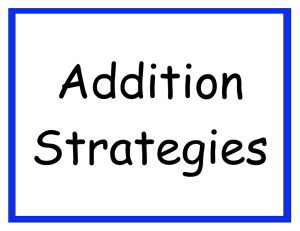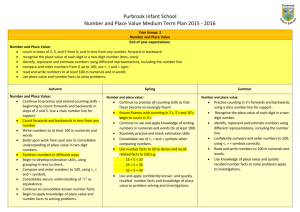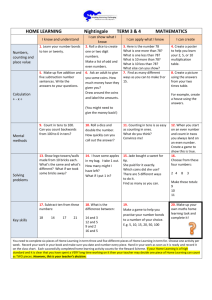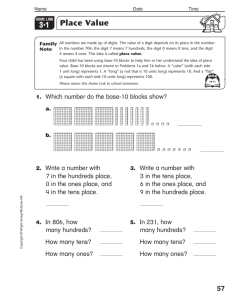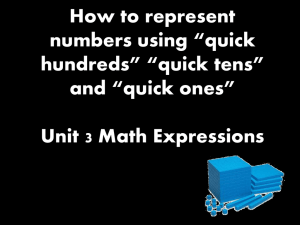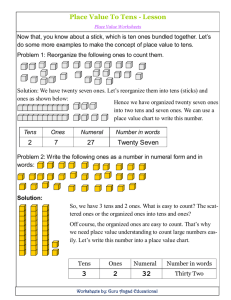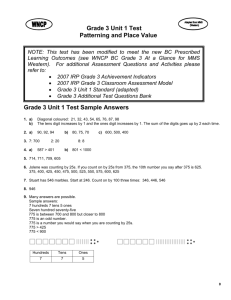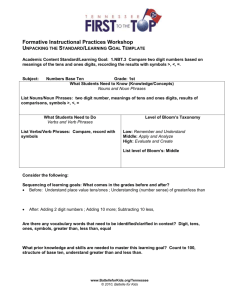Place Value vers 2
advertisement
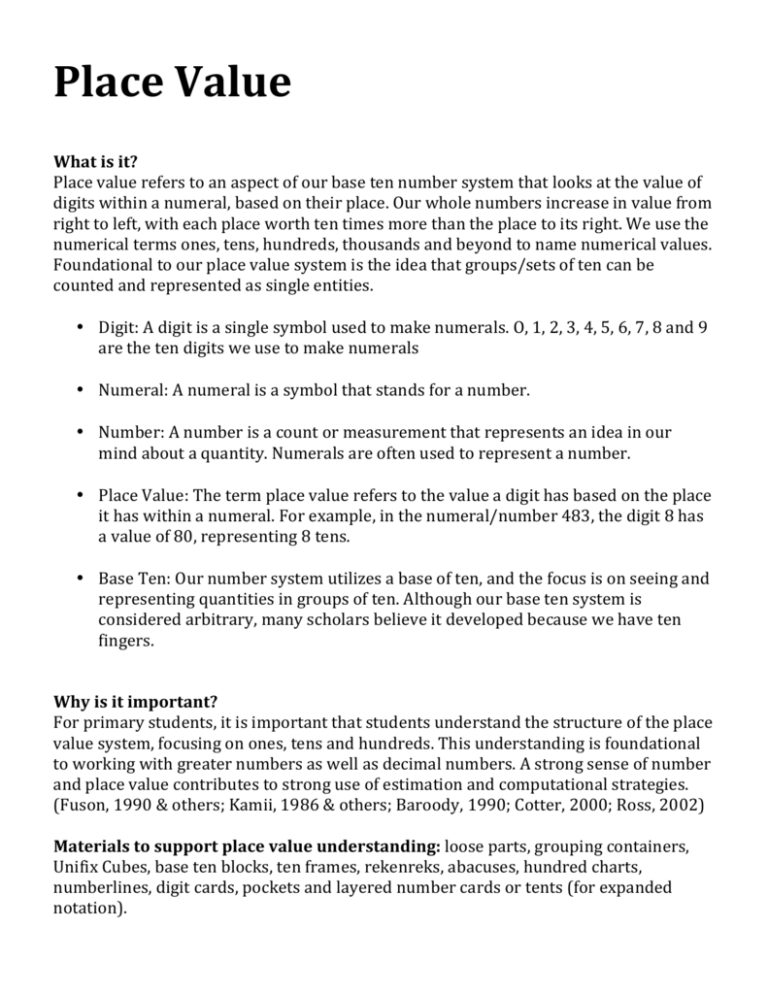
Place Value What is it? Place value refers to an aspect of our base ten number system that looks at the value of digits within a numeral, based on their place. Our whole numbers increase in value from right to left, with each place worth ten times more than the place to its right. We use the numerical terms ones, tens, hundreds, thousands and beyond to name numerical values. Foundational to our place value system is the idea that groups/sets of ten can be counted and represented as single entities. • Digit: A digit is a single symbol used to make numerals. O, 1, 2, 3, 4, 5, 6, 7, 8 and 9 are the ten digits we use to make numerals • Numeral: A numeral is a symbol that stands for a number. • Number: A number is a count or measurement that represents an idea in our mind about a quantity. Numerals are often used to represent a number. • Place Value: The term place value refers to the value a digit has based on the place it has within a numeral. For example, in the numeral/number 483, the digit 8 has a value of 80, representing 8 tens. • Base Ten: Our number system utilizes a base of ten, and the focus is on seeing and representing quantities in groups of ten. Although our base ten system is considered arbitrary, many scholars believe it developed because we have ten fingers. Why is it important? For primary students, it is important that students understand the structure of the place value system, focusing on ones, tens and hundreds. This understanding is foundational to working with greater numbers as well as decimal numbers. A strong sense of number and place value contributes to strong use of estimation and computational strategies. (Fuson, 1990 & others; Kamii, 1986 & others; Baroody, 1990; Cotter, 2000; Ross, 2002) Materials to support place value understanding: loose parts, grouping containers, Unifix Cubes, base ten blocks, ten frames, rekenreks, abacuses, hundred charts, numberlines, digit cards, pockets and layered number cards or tents (for expanded notation). What to think about? • Begin by ensuring that students have one-­‐to-­‐one correspondence and are able to count beyond ten. In particular, students should demonstrate an ability to count all, count on, decomposing/recomposing parts and making ten. • Begin developing base ten understanding by working with groups of tens, moving to the use of a ten frame. From here, move to developing understanding of ten as a unit – for example, counting groups of tens. • Provide students with multiple opportunities to use various concrete materials to create representations for numbers. • Create opportunities for students to work with a quantity of materials where students group materials into tens and see and name the quantity as a specific number of tens plus some “ones” remaining. • A variety of both mathematically structured materials such as Unifix cubes, base ten blocks and Cuisenaire rods as well as other materials such as rocks, shells and buttons offer different possibilities for thinking about groups of ten and representing numbers. Note: Depending on the time of year and your students, consider the quantity of materials (ie. in Kindergarten students may focus on teen numbers – ten and some ones) moving to consolidated understanding of teen numbers in grade 1 and two-­‐digit numbers to 99 in grade 2. What to do? Gather students together and bring out a small bag of materials (counting collection). Spill the materials in front of you on the carpet and ask: How many do you think there are? How could we count them? Have students share their ideas and record the ways students counted on a chart/whiteboard. If students haven’t suggested counting by 10s and 1s, then share that way of counting. Provide pairs of students with their own bags of materials to count and have them count the collection by grouping in 10s and counting on the extra 1s. Either in math notebooks, on a clipboard or on a chart/whiteboard, have students record their count beginning with a pictorial representation (groups of tens and ones) and then the symbolic notation of the number, representing the quantity counted. Have students trade their counting collections and continue with the process. Bring students together to compare their recordings and what they noticed – how are these alike and different? Ongoing experiences could include mini-­‐lessons as needed, games for practice and building fluency, (eg. Five Towers, Ten Frame and Hundred Chart games such as roll and fill to a specific number) and provocations. Some examples of place value provocations include: What can you find out about numbers? (provide a 100-­‐chart and pebbles) Choose three digits. What different numbers can you make? How many different ways can you decompose ________? How are numbers are used in the world around you? How can you compare and sort these numbers? What to look for? Provide students with a small collection of materials to count. Are students able to form and count groups of tens? Are students able to interpret a set of materials as groups of ten and extras/leftovers? Prompt students to record pictorially and symbolically. Are students able to do this accurately? Do students use a form of representation like a dot or tally mark to represent a cube? Do students understand that a digit represents a place value? (ie. for a quantity of 52, do they record the number 52 or 502 to represent 50 and 2). After time working with the counting and recording with tens and ones, ask students to describe the concept of place value. Are students able to decompose a number into tens and ones? Are students able to generalize that a digit in the tens place can represent a set of groups? Are they able to generalize this to larger numbers? Do they understand the role of zero as a placeholder? (ie. in the number 408, the zero indicates there are zero tens) Are students able to talk about the big idea of place value within our number system? What next? 1) If a student is having difficulty, reduce the quantity being used (ie focus on teen numbers, moving into 20s and 30s.). Students need many experiences counting and grouping with materials and conceptual understanding develops over time. Continue to return to these concepts over the school year. Ensure students have a strong understanding of ten as a quantity and can count by 10s, using a number line, ten frames or a hundred chart for support as necessary. Practice counting on from tens, for example, 10, 20, 30, 31, 32, 33, 34. 2) If a student is fluent and confident, extend the number range he or she is working with (ie to hundreds, thousands, etc). Play with ideas such as ways to decompose numbers in different ways, using different benchmark numbers such as 50. Make connections between our place value-­‐based number system and our monetary system. Some students may be interested in investigating other number systems or bases. References Big Ideas from Dr. Small: Grades K-­‐3, Chapter 2-­‐Number and Operations by Marian Small Making Math Meaningful to Canadian Students, K-­‐8 by Marian Small Developing Number Concepts: Place Value, Multiplication and Division by Kathy Richardson Zeroing in on Number and Operations: Key Ideas and Misconceptions (Grades 1-­‐2) by Linda Dacey and Anne Collins It Makes Sense! Using Ten-­‐Frames to Build Number Sense by Melissa Conklin It Makes Sense! Using Hundreds Chart to Build Number Sense by Melissa Conklin Using Language and Visualization to Teach Place Value by Joan Cotter (Teaching Children Mathematics, October 2000) Place Value: Problem Solving and Written Assessment by Sharon Ross (Teaching Children Mathematics, March 2002) Real World Connections Have students notice where they see numbers at home and in their community such as in addresses, license plates, digital clocks, calendars, prices at stores, etc. Have students discuss how numbers are used to help us organize and communicate. Children’s Literature How Big is a Million? by Anna Milbourne Let’s Count to 100! by Masayuki Sebe The Case of the Missing Birthday Party by Joanne Rocklin One Hundred Ways to Get to 100 by Jerry Pallotta created for the BCAMT Reggio-­‐Inspired Mathematics Inquiry Project/SB&JN December 2015

